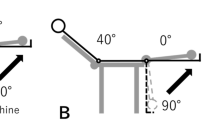Summary
Under the equitonometric conditions of rest, man is found to have a predominance of the muscular tone of the trunk flexors, which is manifested by the anterior bending of the trunk (bending “posture” of rest). This predominance is connected in the main with the resilient traction of the iliac-lumbar muscles. The length of “rest” for the iliac-lumbar muscles is attained at a coaxial angle of about 120° It is presumed that in postural activity the system of reflex to extension of the spine extensors is activated through the receptors of the extended iliac-lumbar muscles. This activating influence is ended upon attainment of the length of “rest” for the iliac-lumbar muscles, i. e, at a coaxial angle of about 120°. This mechanism is used for explaining the electrical silence in the spine extensors occurring in the standing and sitting posture at a coaxial angle of about 120°. A special case is the “flexor relaxation” of the spine muscles described by Floyd and Silver.
Similar content being viewed by others
Literature Cited
I. A. Arshavskii, Pediatriya, No. 4 (1955), p. 49.
V. S. Gurfinkel', The Stance of Healthy Persons and Patients with Artificial Limbs after Amputation of the Lower Limbs, Doctorate Dissertation, Moscow (1960).
V. M. Kamenskaya, Fiziol. Zh. SSSR, No. 3 (1955), p. 353.
V. D. Razanova, Proceedings of the Second Scientific Conference on Age Morphology and Physiology [in Russian], Moscow (1955), p. 212.
V. S. Farfel', The Principle of Equitonometry, Proceedings of the Sixth Joint Scientific Conference of Physiologists of Pedagogic Institutes in Transcausasia [in Russian], Tbilisi (1959).
V. S. Farfel' and Ya. M. Kots, Ortoped. Travmatol. No. 11 (1959), p. 72.
A. S. Shabashova, Balance of Tone of Antagonist Muscles, Candidate Dissertation, Moscow (1947).
Yu. S. Yusevich, Electromyography in the Clinical Study of Nervous Diseases [in Russian], Moscow (1958).
E. Asmussen, Acta Orthop. Scand., Vol. 29 (1960), p. 276.
J. V.Basmajian, Anat. Rec., Vol. 132 (1958), p. 127.
E. J. M. Campbell and J. H. Green, J. Physiol (London), Vol. 120 (1953), p. 409.
W. E. Floyd and P. H. S. Silver, J. Anat. (London), Vol. 84 (1950), p. 132.
W. F. Floyd and P. H. S. Silver, J. Physiol. (London), Vol. 129 (1955), p. 184.
N. Furuno, Fukuoka Acta Med., Vol. 49 (1958), p. 770.
R. Granit, J. Neurophysiol., Vol. 15 (1952), p. 269.
G. Lehmann, Arbeitsphysiologie, Vol. 11, No. 253 (1940).
P. H. S. Silver (1952), Cited by W. F. Floyd, P. H. S. Silver (1955).
H. Takano and T. Higasni, Kobe J. Med., Sci., Vol. 3 (1957), p. 153.
H. Teshima and J. Tohoku, J. Exp. Med., Vol. 67 (1958), p. 281.
Author information
Authors and Affiliations
Rights and permissions
About this article
Cite this article
Kots, Y.M. Interaction between antagonist muscles of the human trunk in resting conditions and during postural activity. Bull Exp Biol Med 62, 1085–1088 (1966). https://doi.org/10.1007/BF00795443
Received:
Issue Date:
DOI: https://doi.org/10.1007/BF00795443




